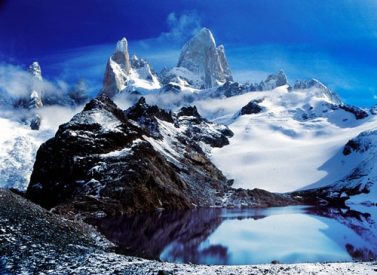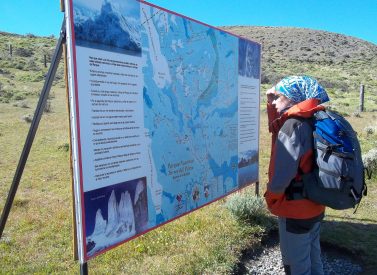The Patagonia Mountain Ranges Explained
 by Tom Shearman on 19th May, 2022
by Tom Shearman on 19th May, 2022

The vast open spaces of Patagonia’s mountain ranges remain an enthralling draw to visitors from around the world.
Be it climbing, hiking, rafting, or wildlife watching, Patagonia’s mountain ranges hold something for everyone. Soaring, ice-capped peaks, glaciers, dense and verdant forests line crystalline lakes and tumbling waterfalls.
Let’s look at Patagonia’s inspiring geography, and the mountain ranges adventure travellers love to explore in Chile and Argentina.

The Andes Mountain Range
Patagonia is part of the Andes mountain range. The Andes are 4,350 miles (7,000 km) in length, making them the most extended continental mountain range in the world.
The mountains are between 124 to 435 miles wide (200-700 km) and extend through seven South American countries:
Venezuela, Colombia, Ecuador, Peru, Bolivia, Chile, and Argentina.
From North to South, Chile and Argentina are home to three different stretches of the Andes.
- The Central Andes (31°–36°S)
- The Northern Patagonian Andes (36°–45°S)
- The Southern Patagonian Andes (45°–55°S)
Each of these three sections of mountains is vast and can be subdivided further.
What Are the Main Patagonia Mountain Ranges?
The Southern Andes is a vast mountain range of which Patagonia is a part. National parks dominate much of the Andean mountains, preserving their beauty for the traveller.
The primary travel regions and mountain ranges in Patagonia, from North to South:
- The Northern Patagonian Andes cover the Chile and Argentina Lake Districts.
- The Southern Patagonian Andes include El Chalten and Mount Fitz Roy in Argentina.
- Cordillera Paine is also in the Southern Patagonian Andes and is home to Torres del Paine National Park (Chile).
- The Cordillera Darwin, which is part of Alberto de Agostini National Park (Chile), is at the very southern tip of Chile.
- The Fuegian Andes in Tierra del Fuego, near Ushuaia and the southern tip of Argentina.

Patagonia Mountain Ranges and Geography: The Lowdown
The significant trajectory of land in the Southern Andes is overflowing with attractions. Northern Patagonia mixes snow-capped volcanoes with thick forests and mountains; the Patagonian Ice Cap is the source of almost 100 glaciers across the region.
Cape Horn and the Magellan Straits, best visited on a Patagonia cruise, allow people to see the Andes from the sea. And while not strictly a mountain range, the enormous semi-arid Patagonian steppe exists thanks to being in the rain shadow of the Andes.
From North to South, some of the Patagonia mountain ranges include the following.
The Northern Patagonian Andes
This range includes ice fields between Mount Fitz Roy and Osorno. The Chile and Argentina Lake Districts bring a different character to southern Patagonia’s vast, remote Andean mountains.
Attractions in Chile include the towns of Chiloe, Pucon, Cochamo, and Puerto Varas. In Argentina, Bariloche is the main focal point, with a vast array of walking trails.
The natural environment is stunning on both sides of the border. Sparkling lakes and temperate rainforests hug smouldering volcanoes whose hidden heat births hot springs. The mix extends to the area’s inhabitants, from indigenous Mapuche to fishers and descendants of German settlers.
Chiloe Island showcases the contrasts within Southern Patagonia. The Lake District is home to countless attractions, from waterfalls to lakes of incredible beauty.
Cochamo is one of the lake district’s hidden gems, with various day hikes among enormous granite peaks and thick forests. It’s known as Chile’s Yosemite but has a distinctive personality.

The Southern Patagonian Andes
This range rises north of the Strait of Magellan and includes Mount Fitz Roy, the Patagonia Ice Cap, and much more.
In Argentina, one of the prime attractions in the Patagonian Andes is Los Glaciares National Park. This national park boasts Perito Moreno glacier, El Calafate, El Chalten, and Lake Viedma within its boundaries.
Mount Fitz Roy (3,405m/11,117ft), Cerro Torre (3,128m/10,262ft), and Pliegue Tumbado (1,500m/4,921ft) are among the hiking attractions on what is known as the Fitz Roy M circuit, accessed from El Chalten.
Perito Moreno glacier is a vast, beautiful, and moving glacier that calves spectacularly into the icy turquoise waters of Lago Argentino. Visitors can hike on the glacier and beautiful surrounding forests or watch icebergs crash into the water from the shore, or go up close on a boat trip.
Estancias and ranches offer visitors a glimpse into the traditional gaucho lifestyle, with overnight stays possible in some truly stunning and remote areas.

Cordillera Paine
Part of Torres del Paine National Park, Cordillera Paine includes the Towers of Paine and is home to the famous Paine W and Paine ‘O’ Circuit trek.
More than 225,000 hectares / 550,000 acres of wilderness await, with sheer granite towers, grumbling glaciers, and lakes of lapis lazuli colour. The UNESCO-protected park also features cascading waterfalls, snow-capped peaks, and walking trails of beauty.
Los Cuernos del Paine (Horns of Paine) and Monte Paine Grande are two beautiful mountains in the park. In the park’s heart, wonderful views abound, too, especially from the French Valley.
Wildlife enthusiasts can track pumas, spot condors or guanacos or look for one of more than 400 bird species that call the park home.

Cordillera Darwin
Entirely in Chile, Cordillera Darwin ranges from the Beagle Channel in the south to Almirantazgo Fjord in the north. Travellers can appreciate the Cordillera Darwin on a Patagonia cruise or complete an intrepid and possibly pioneering hike; much of the area is unexplored.

The Fuegian Andes
From the easternmost point of Tierra del Fuego to Grande Island, and includes Mount Darwin. Hikers need to access Ushuaia and the Martial Mountain Range to access the Glacier Martial trek among the Fuegian Andes, one of the most remote treks in Patagonia.

Dientes de Navarino (Teeth of Navarino)
This mountain range has jagged pinnacles that resemble teeth and lies on Navarino Island, south of Puerto Williams, in Chile. A challenging mountaineering and hiking experience for those that travel. Guests can stay at Lakutaia Lodge.

Discover Patagonia Mountain Ranges
Remember that Patagonia mountain ranges are immense if you’re planning a trip to Patagonia. Patagonia’s remote location is part of its appeal. Sometimes, even a 2-3 week trip may mean visiting just one or two of the ranges mentioned.
We’re experts at tailoring adventure trips to these areas, including the logistics that help people hop as quickly as possible from place to place. So whether you want complete disconnection in the middle of nowhere or to see the highlights of a few places, contact us for expert advice.



 a Tailor Made Tour
a Tailor Made Tour 


 a Group Tour
a Group Tour 

















